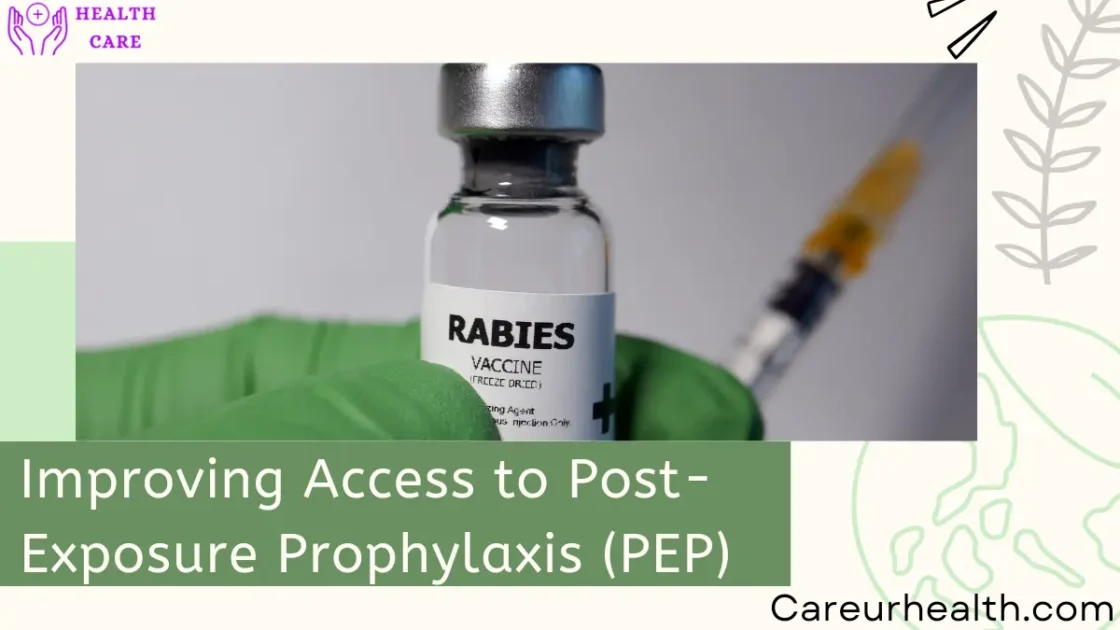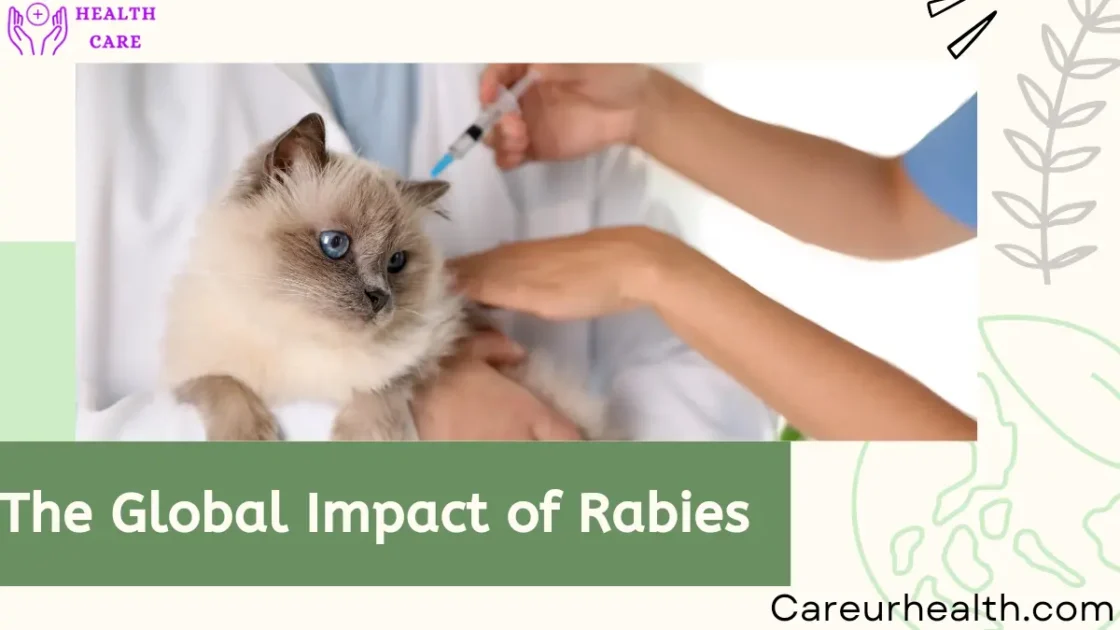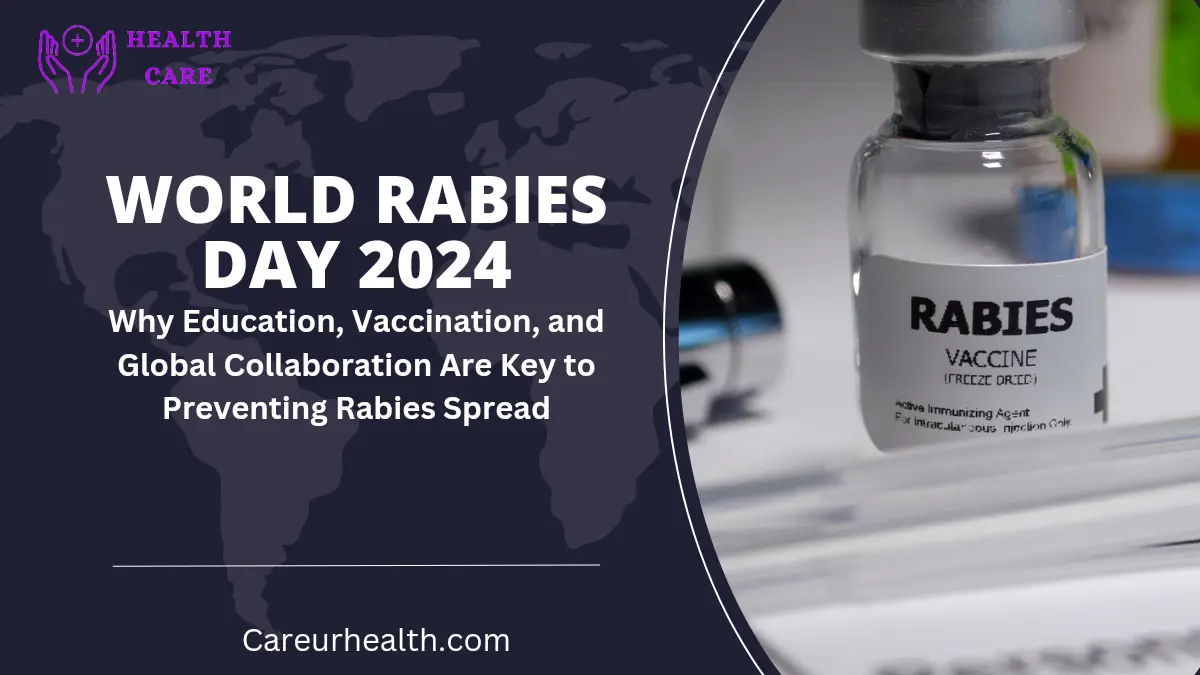World Rabies Day 2024 highlights the importance of global collaboration, public education, and vaccination in the fight against rabies.
This day is dedicated to educating people about rabies prevention, spreading awareness of its risks, and fostering global collaboration to eliminate this fatal disease. World Rabies Day 2024, observed annually on September 28, brings global attention to one of the deadliest yet preventable viral diseases: rabies.
World Rabies Day 2024 will focus on promoting vaccination, responsible pet ownership, and community engagement to reduce rabies cases, particularly in areas where it remains a significant health issue.

Key Takeaways from World Rabies Day 2024
- Rabies is 100% preventable with timely vaccination.
- The majority of human rabies cases result from dog bites.
- Effective rabies control requires a multisectoral approach, including health, veterinary, and wildlife sectors.
- Public awareness and vaccination are key to achieving Zero by 30, the global goal to eliminate dog-mediated rabies by 2030.
- Community participation and education play a crucial role in rabies eradication.
Understanding Rabies: Causes and Consequences
Rabies is a viral disease that affects the central nervous system, leading to inflammation of the brain. Once symptoms appear, rabies is almost always fatal. The virus is primarily transmitted through the bite of an infected animal, with dogs being the main source of human rabies cases.
“Worldwide, rabies causes approximately 59,000 deaths annually, with the highest prevalence in Africa and Asia. However, rabies is entirely preventable through vaccination and public health interventions.”
The Biology of Rabies Virus

Rabies is caused by the Lyssavirus genus and is transmitted through the saliva of infected animals, most commonly dogs.
After entering the body, the virus travels through the peripheral nervous system to the brain, where it causes encephalitis, a severe brain inflammation.
Initial symptoms often resemble the flu, including fever, headache, and general weakness, but as the disease progresses, patients may experience agitation, hallucinations, paralysis, and eventually death. World Rabies Day 2024 will focus on promoting vaccination, responsible pet ownership, and community engagement to reduce rabies cases, particularly in areas where it remains a significant health issue.
Read More:-How to Look After Your Health
Key Facts About Rabies Virus
- Rabies has a long incubation period, which can range from weeks to months.
- Once symptoms appear, rabies is almost always fatal.
- The virus is transmitted through saliva, most commonly via animal bites.
- Rabies primarily affects mammals, particularly domestic and wild animals.
- Early treatment with post-exposure prophylaxis (PEP) can prevent the onset of symptoms.
Human and Animal Impact
Rabies affects both humans and animals, leading to serious health consequences and high mortality rates if not treated in time. World Rabies Day 2024 marks the importance of global collaboration, public education, and vaccination in the fight against rabies.
access to vaccines. Infected animals often display abnormal behavior, such as aggression or lethargy, and can spread the virus to humans through bites or scratches.
Read More:-Comprehensive Overview of Influenza A Virus: Key Facts, Transmission, and Management Strategies
Global Efforts to Eliminate Rabies: ‘Zero by 30’
The World Health Organization (WHO), in collaboration with the World Organization for Animal Health (OIE) and the Food and Agriculture Organization (FAO), has set the ambitious goal of eliminating dog-mediated rabies by 2030 through the “Zero by 30” initiative.
This global strategy aims to reduce human deaths from dog-transmitted rabies to zero through mass dog vaccinations, public awareness campaigns, and improved access to post-exposure treatment.
Mass Dog Vaccination Programs
The most effective way to eliminate rabies is through mass dog vaccination campaigns. Since dogs are responsible for 99% of human rabies cases, vaccinating at least 70% of the dog population in high-risk areas is crucial for breaking the transmission cycle. World Rabies Day 2024 highlights the importance of global collaboration, and vaccination in the fight against rabies.
Many countries have launched large-scale vaccination drives, reaching out to remote areas where dog rabies is most prevalent.
Mass Vaccination Highlights
- Vaccinating 70% of the dog population is key to preventing human rabies cases.
- Mass vaccination campaigns are critical in high-risk areas with limited healthcare access.
- Vaccination programs rely on collaboration between veterinary and public health sectors.
- Community involvement and education are essential for successful vaccination efforts.
- Government and NGO partnerships are vital in sustaining long-term vaccination initiatives.
Improving Access to Post-Exposure Prophylaxis (PEP)

Post-exposure prophylaxis (PEP) is essential in preventing rabies after an individual has been exposed to the virus, usually through a bite. PEP involves immediate wound cleaning, followed by a series of rabies vaccinations.
Timely access to PEP can save lives, but in many rural or underdeveloped areas, it remains difficult to obtain. Strengthening healthcare systems to ensure that people in high-risk regions have immediate access to PEP is a key focus of rabies prevention efforts.
World Rabies Day 2024 will focus on promoting vaccination, responsible pet ownership, and community engagement to reduce rabies cases, particularly in areas where it remains a significant health issue.
The Role of Education and Community Engagement
Public education is one of the most powerful tools in the fight against rabies. World Rabies Day 2024 highlights the importance of global collaboration, public education, as well as vaccination in the fight against rabies.
By raising awareness of the importance of pet vaccinations, proper wound care, and seeking medical attention after a bite, communities can play a significant role in reducing rabies cases.
World Rabies Day serves as a platform for organizations, governments, and communities to educate people on the dangers of rabies and how to prevent it.
Promoting Responsible Pet Ownership
Educating pet owners about the importance of vaccinating their dogs against rabies is a critical part of preventing the disease. Pet owners must be informed that annual rabies vaccinations not only protect their animals but also prevent the spread of rabies to humans.
Key Educational Strategies
- Community outreach programs to raise awareness about rabies transmission and prevention.
- School-based education to inform children about the dangers of rabies and the importance of responsible pet ownership.
- Collaboration with local leaders to promote vaccination drives and educate the public.
- Use of social media and other digital platforms to spread awareness.
- Organizing events on World Rabies Day to engage communities in rabies prevention activities.
In some areas, laws require mandatory vaccinations for pets, but enforcement can be challenging, especially in rural communities.
Key Education Initiatives
- Community education programs are essential for promoting pet vaccinations.
- World Rabies Day activities help raise awareness about rabies prevention.
- Schools play a key role in teaching children about the dangers of animal bites.
- Local governments and NGOs work together to deliver awareness campaigns.
- Veterinary services are critical in reaching out to pet owners in remote areas.
Rural and Urban Engagement
Both urban and rural populations face different challenges when it comes to rabies prevention. In urban areas, stray dog populations and lack of pet vaccinations can be a significant problem, while in rural areas, access to vaccines and treatment is limited.
World Rabies Day 2024 will focus on promoting vaccination, responsible pet ownership, and community engagement to reduce rabies cases, particularly in areas where it remains a significant health issue.
Engaging communities in both environments through public health campaigns, mobile vaccination units, and collaboration with local leaders can help ensure that the message of rabies prevention reaches everyone. World Rabies Day 2024 highlights the importance of global collaboration, public education, and vaccination in the fight against rabies.
The Global Impact of Rabies: A Public Health Challenge

Rabies remains a significant public health concern across the globe, particularly in developing countries where access to vaccines and healthcare services is limited. Each year, approximately 59,000 people die from rabies, making it one of the most fatal viral diseases known to humans.
World Rabies Day 2024 highlights the importance of global collaboration, public education, and vaccination in the fight against rabies. Despite being completely preventable, rabies continues to pose a substantial risk, especially in rural areas where stray dog populations are prevalent, and health education is lacking. Understanding the scope of rabies as a public health challenge is critical for developing effective strategies to combat its spread.
Epidemiology of Rabies
Rabies is caused by the rabies virus, primarily transmitted through the bite of an infected animal. Dogs are responsible for 99% of human rabies cases, particularly in regions where they are not routinely vaccinated.
The World Health Organization (WHO) has identified rabies as a priority disease for elimination. Sub-Saharan Africa and South Asia are particularly affected, with thousands of cases reported annually. The lack of adequate healthcare infrastructure and public health education in these regions exacerbates the problem, resulting in many preventable deaths.
Global Statistics
- 59,000 deaths annually due to rabies.
- Approximately 95% of rabies cases occur in low- and middle-income countries.
- Children under 15 years of age account for 40% of rabies deaths.
- High-risk areas include regions with high stray dog populations and limited vaccination programs.
- Rabies is endemic in over 150 countries, making global eradication challenging.
Challenges in Rabies Control
Controlling rabies presents numerous challenges, particularly in resource-limited settings. Factors such as inadequate vaccination coverage, lack of public awareness, and limited access to post-exposure prophylaxis (PEP) contribute to the persistence of this deadly disease. World Rabies Day 2024 highlights the importance of global collaboration, public education, and vaccination in the fight against rabies.
Vaccination programs often face logistical challenges, including funding constraints and the need for extensive community engagement to ensure compliance. Moreover, misinformation about the disease and its transmission can further complicate efforts to control rabies.
Barriers to Effective Control
- Insufficient funding for vaccination and education programs.
- Lack of trained personnel to administer vaccines and educate the public.
- Cultural beliefs and practices that hinder vaccination efforts.
- Poor surveillance systems that fail to track rabies cases effectively.
- Resistance to seeking medical help after a potential rabies exposure.
The Role of Education in Rabies Prevention
Education plays a crucial role in preventing rabies. Awareness campaigns aimed at educating the public about the risks associated with rabies and the importance of vaccination are vital. Schools, community centers, and local health organizations can serve as platforms for disseminating information.
Educational initiatives should focus on the necessity of vaccinating pets, recognizing symptoms of rabies in animals, and understanding the steps to take after a potential rabies exposure. World Rabies Day 2024 highlights the importance of global collaboration, public education, and vaccination in the fight against rabies.
Key Strategies in Brazil
- Mass vaccination campaigns targeting both urban and rural dog populations.
- Public education initiatives aimed at increasing awareness about rabies and its prevention.
- Collaboration between government agencies, NGOs, and the veterinary community.
- Regular monitoring and evaluation of vaccination coverage and rabies incidence.
- Commitment to sustaining efforts through ongoing funding and community support.
The Importance of Responsible Wound Care and Treatment
After an animal bite, cleaning the wound immediately with soap and water is the first step in rabies prevention. This simple yet effective action can significantly reduce the chances of the virus entering the body. World Rabies Day 2024 highlights the importance of global collaboration, public education, and vaccination in the fight against rabies.
Following proper wound care, it’s essential to seek medical attention as soon as possible, even if the bite appears minor. Healthcare providers will assess the risk and administer PEP if necessary. World Rabies Day 2024 will focus on promoting vaccination, responsible pet ownership, and community engagement to reduce rabies cases, particularly in areas where it remains a significant health issue.
Post-Bite Actions for Rabies Prevention
In many cases, people are unaware of what to do following a bite from a potentially rabid animal. Immediate wound care and visiting a healthcare facility for post-exposure prophylaxis (PEP) can be life-saving.
However, in areas where healthcare facilities are limited, access to rabies vaccines can be a challenge.
Key Actions Post-Exposure
- Clean the wound with soap and water for at least 15 minutes.
- Apply an antiseptic like iodine to reduce infection risk.
- Seek immediate medical care for evaluation and PEP treatment.
- Monitor the biting animal, if possible, to check for rabies symptoms.
- Educate communities on the importance of seeking prompt treatment.
Drishti IAS
Conclusion: Global Collaboration to Eradicate Rabies
World Rabies Day 2024 highlights the importance of global collaboration, public education, and vaccination in the fight against rabies. By promoting mass dog vaccinations, increasing access to PEP, and encouraging responsible pet ownership, rabies can be eliminated.
As we move towards the “Zero by 30” goal, it is essential that communities, governments, and organizations work together to ensure that rabies becomes a disease of the past. Through collective action, we can protect both human and animal lives from this preventable disease.
World Rabies Day 2024 will focus on promoting vaccination, responsible pet ownership, and community engagement to reduce rabies cases, particularly in areas where it remains a significant health issue.
FAQs about World Rabies Day 2024
Q1: What is the theme for World Rabies Day 2024?
A1: The theme for World Rabies Day 2024 focuses on achieving the “Zero by 30” goal, aiming for zero human deaths from dog-mediated rabies by 2030.
Q2: How can rabies be prevented?
A2: Rabies can be prevented through timely vaccination of pets, proper wound care after an animal bite, and seeking post-exposure prophylaxis (PEP) immediately.
Q3: What role does dog vaccination play in rabies control?
A3: Dog vaccination is critical, as dogs are responsible for 99% of human rabies cases. Vaccinating 70% of the dog population can break the cycle of transmission.
Q4: What should I do if bitten by a potentially rabid animal?
A4: Clean the wound thoroughly with soap and water, apply an antiseptic, and seek immediate medical care for evaluation and potential PEP treatment.
Q5: How can I get involved in World Rabies Day 2024?
A5: You can get involved by spreading awareness, participating in local vaccination drives, and educating your community about rabies prevention.










